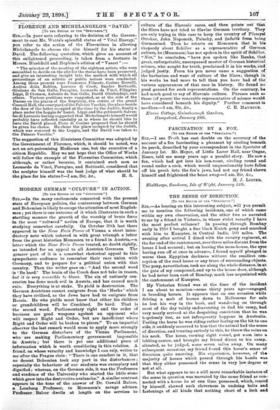FLORENCE AND MICHELANGELO'S "DAVID."
[To THE EDITOR OF THE "SPECTATOR:]
your note referring to the decision of the Govern- ment to cast Mr. Watts's splendid statue of "Vital Energy," you refer to the action of the Florentines in allowing Michelangelo to choose the site himself for his statue of David. The following quotation, which gives an account of this enlightened proceeding, is taken from a footnote in Messrs. Blashfield and Hopkins's edition of " Vasari " :—
"The minutes of the meeting of the eighteen artists who were assembled to decide on the site for the statue have been preserved, and give an interesting insight into the method with which all proceedings of an artistic or public nature were conducted. Among those present were Francesco Filarete, Cosimo Rosselli, Andrea della Robbia, Lorenzo di Credi, Sandra Botticelli, Giuliano da San Gallo, Perugino, Leonardo da Vinci, Filippino Lippi, 11 Cronaca, Antonio da San Gallo, David Ghirlandajo, and others. Various positions were suggested, as at the side of the Dnomo on the piazza of the Baptistry, the centre of the grand .Council Hall, the courtyard of the Palazzo Vecchio, the place beside the door of the latter occupied at the time by the Judith, finally a place under the Loggia de' Lanzi. Lippi and the goldsmith Salves- tro di Lavaccio having suggested that Michelangelo himself would probably have reflected • carefully as to where he should like to lave the David placed, Piero di Cosimo proposed that he should be given his choice. He chose the place occupied by the Judith, which was removed to the Loggia, and the David was taken to -the Palazzo Vecchio."
The suggestion of this illustrious Committee was adopted by the Government of Florence, which, it should be noted, was not an art-patronising Medicean one, but the executive of a citizen Republic. May we not hope that the Office of Works will follow the example of the Florentine Committee, which although, or rather because, it contained such men as Leonardo da Vinci, Perngino, and Botticelli, considered that the sculptor himself was the best judge of what should be the place for his statue P—I am, Sir, Sce., H. S.


















































 Previous page
Previous page